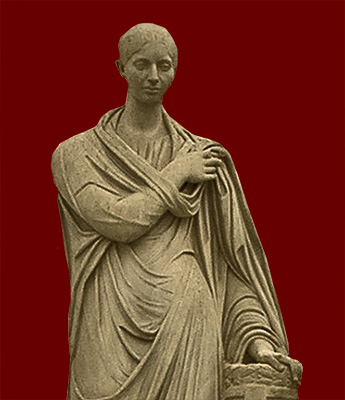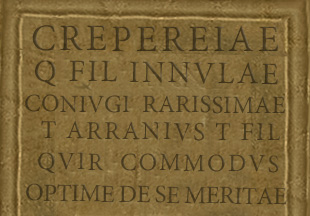
Portrait of Crepereia Innula, 3rd quarter 2nd century CE
Full-length statue. Entire monument
Crepereia Innula survives in name and person in this elegant life-size marble monument, dedicated by her husband Titus Arranius Commodus and unknown until its accidental discovery in 1962 near Haïdra, Tunisia, the modern site of the Roman colony Flavia Augusta Emerita Ammaedara in the province of Africa Proconsularis. She probably lived in the last half of the second century CE, judging from her hair style, which is similar to that of the empresses Faustina the Younger (c.125/30-175) and Lucilla (148-182 CE), her daughter. While her modest pose and dignified bearing, heavily draped in her palla and wearing no jewelry, portray her as a traditional upper-class matrona, the presence under her left hand of a small altar or incense burner (thymiaterion), may be a sign that she was also a priestess, though her epitaph does not mention this. Her name includes her filiation (Quinti filiae), indicating that she was a freeborn daughter of the well-known family gens Crepereia. Although her mother's name is not noted, her father may have been a leading citizen of neighboring Theveste (Tebessa), Quintus Crepereius Rufinus, who is praised in his epitaph for his generous benefactions to his city and for the numerous public offices he held (CIL 8.16556). Her cognomen, Innula, may have originally been a nickname derived from hinnuleus “fawn” (as a pet term for a girl, see Horace I.23.1). Innula's husband, also freeborn (Titi filius), was a Roman citizen enrolled in the Quirina voting tribe; he may have been an eminent citizen in the colony, but he was certainly wealthy, as indicated by the opulence of his tribute to his wife. Although this monument was set up in a private tomb and the epitaph uses conventional funerary language, its design emulates honorific statues, such as that of Plancia Magna, erected in public places to honor civic benefactors. While many inscribed statue bases have survived, very few of the statues that originally stood atop them are extant, especially statues of women, making this intact monument a rare find. In fact, when this was first uncovered, the villagers, believing that the woman so honored must have been an important public figure, dubbed her “the Queen of Ammaedara.” In the same findspot a portrait bust of Innula was found bearing an identical epitaph; the bust seems to depict her as a slightly older woman, but unfortunately the face was damaged in the excavation. Both inscriptions consist of six brief lines, deeply carved with well-formed letters; four of the lines bear the names of wife and husband, the remaining two are in praise of Innula.

Inscribed marble statue base for Crepereia Innula
last quarter 2nd century CE (
AE 1966.525)
Click on the underlined words for translation aids and commentary, which will appear in a small window.